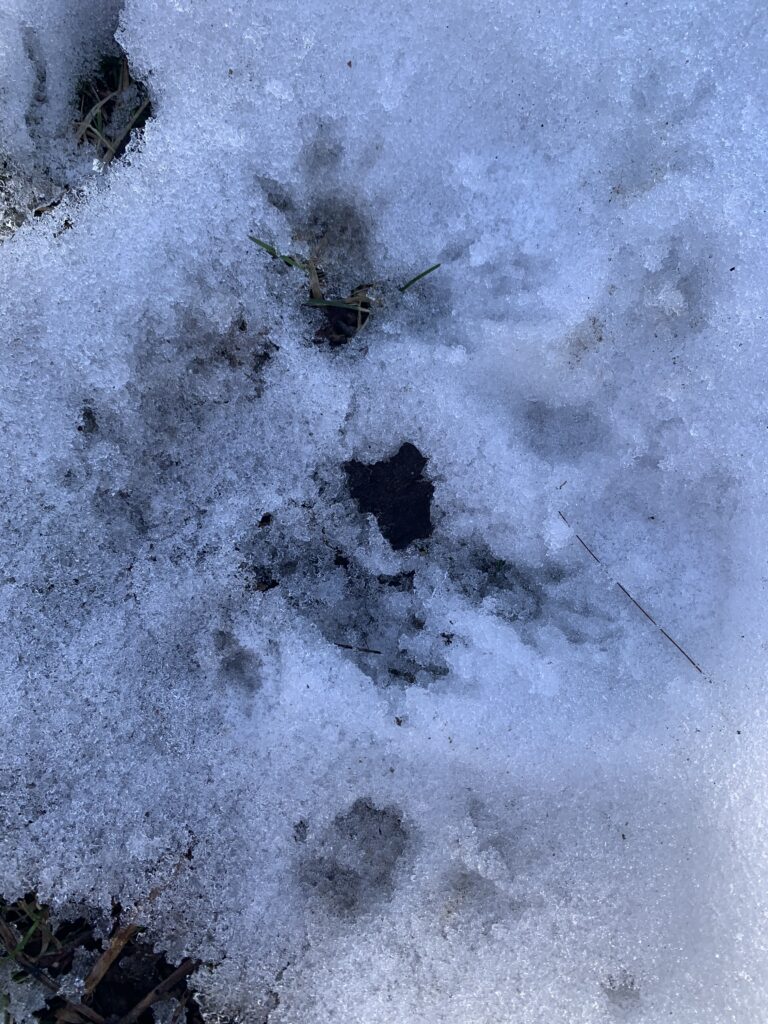For wildlife tracking this week, I decided to visit the South Burlington Rec Path, which runs from the Patrick Gym all the way to a shopping center on the south side of town, as well as a loop trail that runs by the Bio Research complex on Spear Street. Hopefully, this route would provide a lot of tracks that have not been mapped by others yet.

As the trail was located along the road for a good stretch, the traffic noise presumably drove away a lot of the animals. The only wildlife I saw along the route was an American Crow or two, as well as a lot of domesticated dogs on leashes following their owner. This fact was evident by the numerous paw prints found in the mud along the way!

Though I at first let myself fantasize about the possibility of the print pictured above to be from a big cat, like a catamount, I knew it couldn’t be true. With the human presence constantly along the trail both in the forms of cars and bikers, and the abundance of dogs, the print almost certainly belongs to a dog. Though tracking isn’t my strong suit, it was helpful for me to examine context clues from my surroundings to hypothesize which sort of creatures would traipse along these landscapes, and ask “why” they would be doing so.
This was also the time where I first used INaturalist to see what ID suggestions would pop up for this print. I’ve used INaturalist before in high school and in NR095 – Urban Ecology, so I was used to the program providing accurate identifications for plants and animals. However, when I submitted this photo, it did indeed come up with the domesticated dog as a top suggestion. These gave me confidence that it could help me with my tracking moving forward.

Next, it was time to put the boots I was wearing to the test and walk into the snowy woods to see what I could find. Though I was initially worried that I wouldn’t be able to find the tracks, I found a lot in a short time span!

The first print I saw was this relatively freshly made track. As it has 4 toes with what seemed to be an x and claws, I knew it had to be either a fox or wolf. However, I wasn’t completely sure if I could rule out a dog either, as this was pretty close to the trail and I had seen dogs making similar prints. The bottom part of the print seems to resemble that of a wolf or coyote, but the claws do not seem to line up with the way they are oriented in the tracking guide.

This third print was interesting. Though this print didn’t go far in terms of detail, the tapering from top to bottom reminded me a lot of the snowshoe hare, and the length lines up with what was in the tracking guide. It was the only track like this in the vicinity, and Inaturalist had this as a top suggestion when I entered it into the program.

The last prints worth mentioning (I found A LOT of dog prints) was this curious collection of small prints, I think from an eastern gray squirrel. I found one in the vicinity as well as a nest in a nearby tree, meaning that it was likely the culprit of these tiny prints in the melting snow, not to mention they look like the prints described in the guide.
Though tracking takes a long time to be done right, I am proud of what I accomplished today. Tracking encourages me to look closely for the more-than-human world and think about what animals are nearby and why. Using context clues and INaturalist really helped me along in my identification and because practice makes perfect, continuing to engage in this sort of identification will be key in becoming a more knowledgable tracker!
